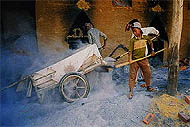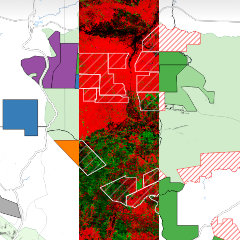Joint Research Report Released on Impact of Child Labor in Cambodia
ចេញផ្សាយ ថ្ងៃទី១២ ខែឧសភា ឆ្នាំ២០០៨Sophal* was only six when he became a child brick factory worker. The rest of his family has spent over five years working in the brick factory. Together, the family of five earns less than US$25 per month. The work is hard, and the children often get sick. The job involves repetitive lifting, carting and drying of clay, and hauling brick blocks in and out of hot furnaces.
Sophal and his siblings, aged 9 and 12, do not go to school. Despite the jobs' undesirable conditions they have no other choice; their parents feel that they have to work to help support the family, rather than go to school.
"Working in the brick factory, my children face the risk of getting their hands caught in clay cutting machines, or coughing up blood from carrying heavy loads of clay. I have been thinking about changing jobs, but I cannot since I have no place to stay and cannot afford to pay rent. This factory gives us a room to stay in; although small, it's better than nothing," says Sophal's mother.
On May 7, World Vision Cambodia (WVC) and LICADHO launched a joint research report "Child Labor in Brick Factories - Causes and Consequences" at a workshop in Battambang city. The research, conducted in July 2007, aimed to identify causes and consequences of child labor in brick factories in the surrounding areas of Battambang city. The research report is a part of WVC and LICADHO's 3 year campaign to combat the worst forms of child labor in Cambodia.
The study surveyed 132 child laborers, 43 parents of child laborers and 15 brick factory owners/managers from 26 brick factories. The survey found that family economic hardship is the leading cause of child labor, with over 70% of the families needing to send their children to work in order to earn money for food. The average wage of a child worker was found to be 5000 riel (USD$1.20) for an 8-hour work day.
Poverty drives parents to send their children to work in brick factories, despite the often dangerous working conditions. Nevertheless one third of the parents interviewed did not perceive working in the brick factories as high risk jobs for their children.
Over 95 people attended the report launch workshop including child laborers, parents of child laborers, factory owners, NGO staff, commune council leaders, district and provincial governors and deputy governors.
The following day after the workshop, a public concert was held to raise awareness amongst the public about the dangers of child labor. The concert showcased popular singers and comedians who both entertained and educated the 3,000 strong audience. The event marked the third concert for the campaign to combat the worst forms of child labor. Two previous concerts were held in Phnom Penh promoting campaigns to combat child labor in brick factories (August 2007) and also child labor in the entertainment industry (November 2007).
LICADHO and WVC urge parents, children and brick factories employers to improve their understanding of the dangers facing children and to understand the need to protect children from the worst forms of child labor.
*Not his real name
- ចំណងជើង & មូលបទ
- សិទ្ធិកុមារ ពលកម្មដោយបង្ខំ និងទាសភាពបំណុល
- ឯកសារទាក់ទង







